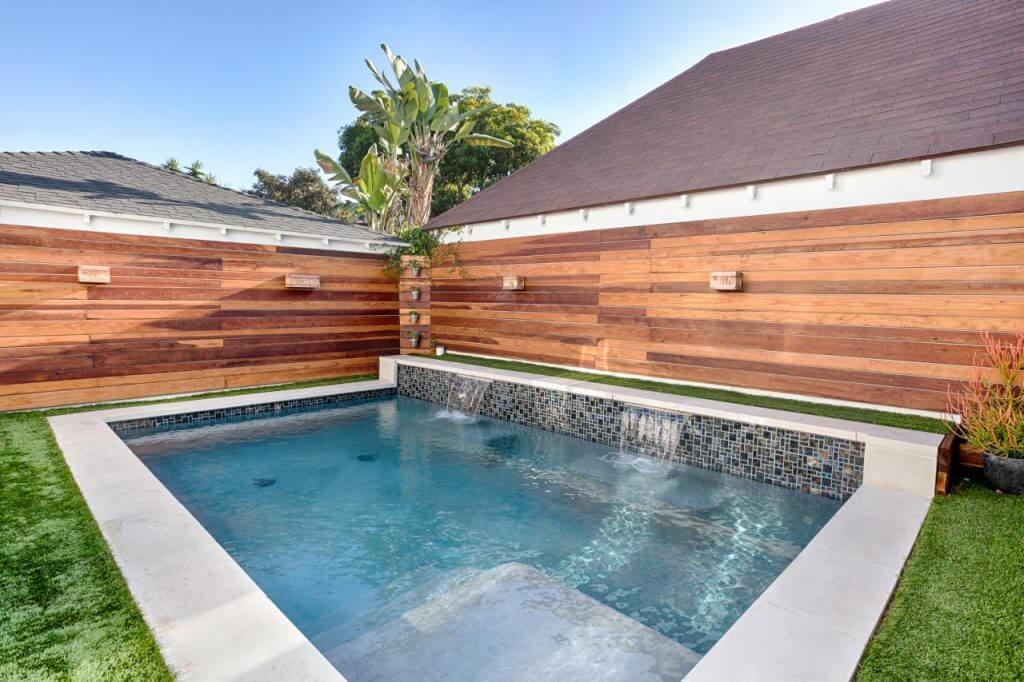When you are shopping for in-ground fiberglass pools, you will find that you have three main options as to the types of pools. Concrete, fiberglass, and vinyl liner swimming pools are all great products and each has its own advantages. Concrete pools are great for customization and simplicity. Vinyl liner pools can be installed at much lower initial investment. Fiberglass pools have somewhat limited customization and more upfront costs, but they are the quickest to install, require less maintenance and use less energy than vinyl and concrete.
There are some myths circulating about the drawbacks of fiberglass pools. Read on to find out the real truth from the experts.
Fiberglass Pools Will Float or Pop Up
The most common myth surrounding fiberglass pools is that they can float or pop up out of the ground because of pressure building up underneath the fiberglass shell. This can occasionally happen in a fiberglass pool that has no water in it, but not in a pool that contains water. Merely keeping water in your pool prevents this from ever happening and your builder can also install a sump pump if your pool placement on your lawn is in an area where water tends to pool and collect.
Fiberglass Swimming Pools are Cheap and Ugly
When fiberglass pools very first hit the market, there really weren’t many options to make them attractive. But, just like with all products when they have been on the market for longer periods of time, there are many great features added to them. Today’s fiberglass pools are aesthetically pleasing to be as stylish as a concrete or vinyl liner pool. Fiberglass pools can be dressed up with coping, colored finishes, tiles, and lighting to be very attractive, and all these items are available through a swimming pool supply store.
Fiberglass Pools Won’t Operate in Very Cold Climates
Another myth about fiberglass pools is that in very cold weather the shell will freeze and shatter. This isn’t true at all because water expands upward not outward when it freezes. Any ice formations in your swimming pool will rise up over the edges of it and they won’t press against the walls. You can have peace of mind in colder climates by winterizing your pipes to allow the water to flow through them all year. Actually, no matter what your pool is made of, it should ideally be winterized in cold regions.
Fiberglass Pools Cost Much More Than Vinyl Liners
The actual cost of your swimming pool is determined by many different factors, such as the size, how easy your yard is to access, the distance for the crane, what season it is, and all of the customizations that you want to add to your pool. For an example of the comparison of these two types of pools, a fiberglass pool package can run from $45,000 to $85,000 and a vinyl liner of the same size with the same customizations would be about $36,000 to $85,000. So, there is actually not much difference between the two types as to the initial cost.
Something else to think about is your future costs for chemicals, electricity, maintenance, and repairs. Over about ten years a vinyl liner will be around $11,500 for these items whereas a fiberglass pool would be about $3,750 for the same items, which saves you money in the long run.
Fiberglass Pools Have Little Customizations
This myth is that after you install a fiberglass pool you can’t customize it and it will be plain. The shell shape and size can’t be changed, but you have many different options to customize your fiberglass pool to the look and feel that you desire. Customizable options include:
- Coping
- Color
- Shape
- Size
- Spas
- Tanning ledge
- Tiles
- Water features
The coping is the material that is used to outline the top of the fiberglass swimming pool shell. You can choose from many different textures and colors to personalize your pool.
Fiberglass pool shells come in a wide range of colors from which to choose.
There are various pre-fabricated shapes of fiberglass pools such as circles, ovals, rectangles, squares, and many others as well.
The size of your fiberglass pool also gives you a variety so that you are sure to find a pool shell that will fit in your backyard or recreation area of your home.
You can add a spa on the side of your pool to customize the appearance and match the other components of your pool.
The addition of a tanning ledge allows swimmers to sunbathe near the water on a small-scale wet deck.
There are many different types of tiles and colors that you can add around the edge of the pool to increase its aesthetics.
You can also add wonderful additional features such as a bubbler, waterfall, or jets to your fiberglass pool for customization and beauty.
A splash pad can also be added to your fiberglass pool which is a damp deck that can be filled up to a foot deep with water so children have a safe environment in which to play, or anyone relaxing and not swimming can sit and enjoy the cool water temperatures.
Conclusion
Fiberglass pools have an initial high investment cost, but they will actually pay for themselves in the long run when you compare all the maintenance costs to other types of pools. If your pool is installed correctly and you keep it maintained, you will have no issues with a fiberglass swimming pool.
At Aqua Guard 5000, we have over 30 years of experience in swimming pool installations of all types. We believe in 100% customer satisfaction and will work with you to stay within your budget while providing you with all your options. Contact us today to learn more about the similarities and differences in swimming pools or to shop for a pool paint, restoration, and repair products for your existing pool.








